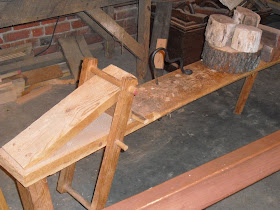One of the things I really miss about woodworking back east is the availability of good wood. The lumberyards I used to purchase from back in Amish country stocked everything from all the domestic hardwoods in dimensioned sizes to obscure domestic species, like elm or sassafras. You haven't really experienced the joy of woodworking until you've worked with sassafras, enjoying its aroma.
Here? You're lucky to find decent boards of the domestics - maple, walnut, and cherry. Much of it is twisted and split, probably from the dry conditions here in the desert. It's odd to me that alder is so popular here - it's boring and dull, but some people just love it. It reminds me of Basswood, now who would build a kitchen out of that?
As my friend John says - people here often have champagne budgets and beer taste.
A few weeks ago, I slipped in a short vacation to Asheville, North Carolina to visit family, and had a chance to visit Biltmore. We toured the house, which was quite amazing. As a woodworker, it was hard to ignore all the work that went into the home and the furnishings.
After the tour, I headed over the woodshop, to see where the magic happens.

The woodshop isn't much bigger than a small garage, but it contained an impressive number of tools.
Ahh.... I miss seeing logs like this!
The interior had the standard tools you'd expect to find -

Here? You're lucky to find decent boards of the domestics - maple, walnut, and cherry. Much of it is twisted and split, probably from the dry conditions here in the desert. It's odd to me that alder is so popular here - it's boring and dull, but some people just love it. It reminds me of Basswood, now who would build a kitchen out of that?
As my friend John says - people here often have champagne budgets and beer taste.
A few weeks ago, I slipped in a short vacation to Asheville, North Carolina to visit family, and had a chance to visit Biltmore. We toured the house, which was quite amazing. As a woodworker, it was hard to ignore all the work that went into the home and the furnishings.
After the tour, I headed over the woodshop, to see where the magic happens.

The woodshop isn't much bigger than a small garage, but it contained an impressive number of tools.
Ahh.... I miss seeing logs like this!

including this lathe
The display of hand planes was quite nice, and you could tell that these weren't just for display. There were shavings on the ground, and some nicely milled boards on the bench.
Since there were a few craftspeople working in some of the shops, I'd hoped that there might be a woodworker on site, but... no such luck.
If you closed your eyes to blot out all the people taking photos with their iPhones or digital cameras, you could almost transport yourself back to an era where woodshops looked like this.
On a good note, I may have some sassafras arriving in Las Vegas any day now. I've arranged to buy some, the shipping details are still being worked out. I'm not sure what I'll make, but I'm sure I'll wind up doing something special with it. If you detect a lovely sarsaparilla smell coming from my dust bags, you'll know what I've been doing.



























































